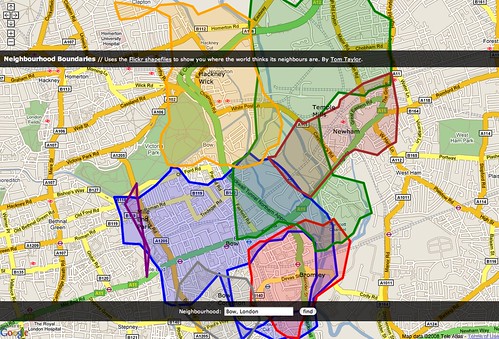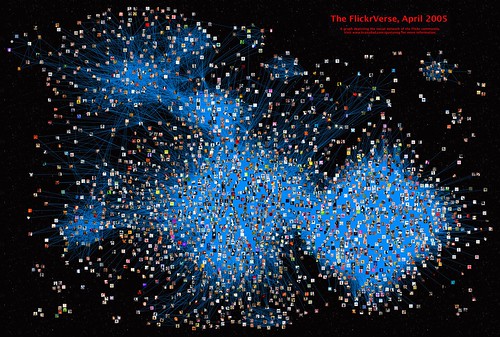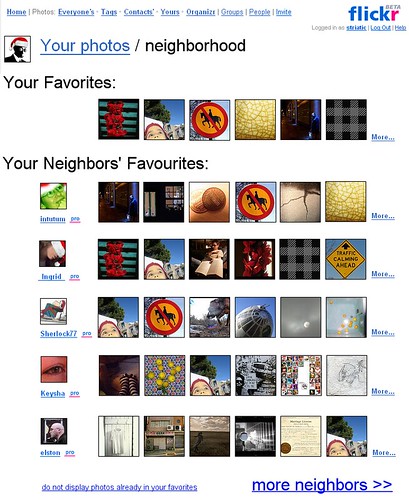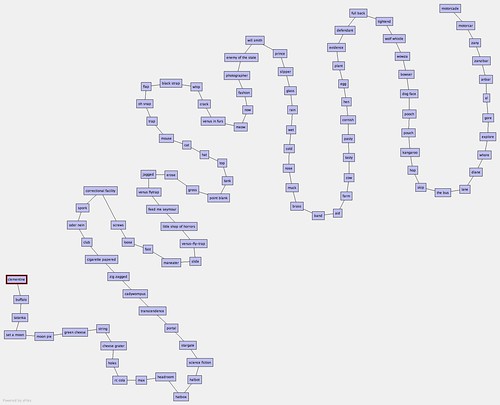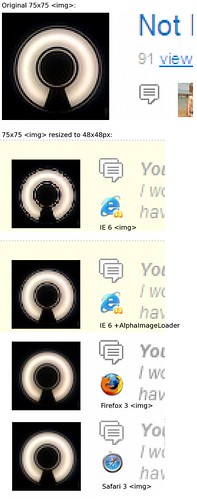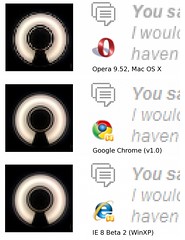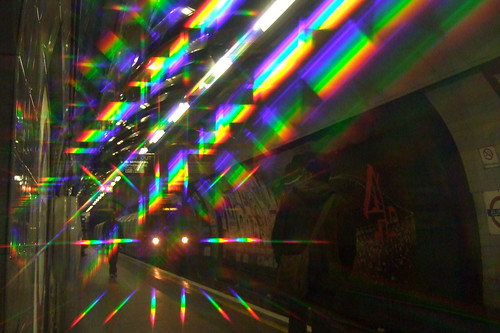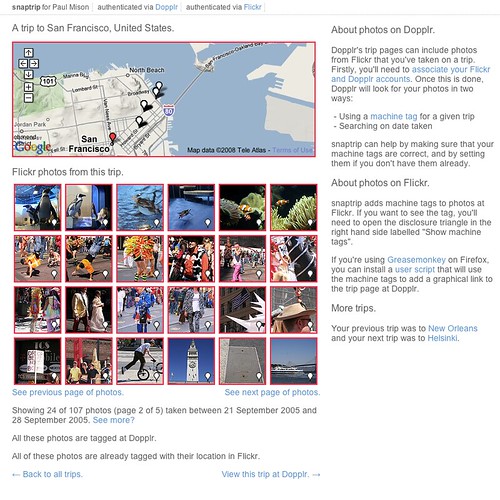Resizable apps are groovy. Users want content to fill the screen, and as the variance in screen resolutions has grown this has become more and more important. To make this happen you can either write manual positioning code to place and size items on window resize, or you can define a hierarchy, some properties on elements of the hierarchy and have a layout engine do the work for you. Up until a few years ago, there were no good pre-built solutions to do this in Flash so the only option was to roll your own framework. Nowadays there are several floating around, including this one from the flash platform team at Yahoo!, and of course there is the Flex/MXML route.
XML based UI markup seems to be all the rage these days, but what I found personally through my experience building the jumpcut tools is that this “responsible” approach has drawbacks. A hierarchy of HBoxes and VBoxes can be a lot of overhead for simple projects, and can become unwieldy and rigid when you are trying to develop something quickly. If you are doing anything weird in your UI (overlapping elements, changing things at runtime) it can also feel like trying to fit a square peg in a round hole.
The Best of Both Worlds
So is there any way to get at a sweet-spot, something quick and flexible, yet powerful? The first thing that probably comes to mind if you are a web developer is the CSS/HTML model. In fact, I think would be a rather good option if not for one missing piece, the unsung hero of the web: the HTML rendering engine. If anyone wants to implement Gecko or WebKit in ActionScript I think that would be a fun project, but because the web ecosystem evolved with the markup user and not the layout engine implementer in mind it’s rather complicated. There is also the fact that this model is based on the assumption of a page of fixed width but infinite height which doesn’t exactly suit our purposes.
What we can borrow though is the philosophy of good defaults and implicit rather than explicit layout specification. When you are building out a layout with HTML/CSS you can just drop stuff on the page and things more or less work and resize as you’d expect, then selectively you can move things around / add styling and padding and so on. To do something similar we can take advantage of one of the nice new features of Actionscript 3, the display hierarchy, which allows us to easily traverse, observe, and manage all the DisplayObjects at run time, without keeping track of them on our own as they are created. This way we can recurse through the tree, look for the appropriate properties, and apply positioning and sizing as necessary. If the properties don’t exist we’ll just leave things alone. When you start your project you can just write code to position stuff manually, then as things get more complex and start to solidify you can begin using layout management where it makes sense. I’m a bit of a commitment-phobe myself, so this really appeals to me; what’s especially nice is that you easily plug this in to any existing codebase.
Some Code
So, to get this working all we really need is a singleton that listens to the stage resize event, traverses the tree and places/sizes objects. Mine looks something like this:
/*..*/
stage.addEventListener(Event.RESIZE, this.onResize);
/*..*/
function onResize(e:Event){
this.traverse(root);
}
function traverse(obj:DisplayObject){
for (var i=0; i < obj.numChildren; i++){
var child = new LayoutWrapper(obj.getChildAt(i));
if(child.no_layout)
continue;
//layout code to determine how to place and size children
//child.x = something
//child.y = something
child.setSize(W, H); // pre-order
this.traverse(child);
child.refresh(); // post-order
}
}
Two things of note here.
First is the LayoutWrapper which I use to set defaults for properties and functions that don’t necessarily exist on all objects, so sort of like slipping in a base class without having to alter any code. I use flash_proxy to make this easier, but you don’t have to do that. One thing you will want to do is store dummy values for width and height (something like _width and _height maybe as a throwback) so you can assign and keep track of the width and height of container elements without actually scaling the object. You’ll also want to decide how you want to handle turning on / off the layout management and what defaults make sense for you. In the above code I’m doing opt-out, using a no_layout variable to selectively turn off layout management where I don’t need it.
Second, I have two hooks for sizing, setSize on the way down, and refresh on the way up. This is useful in some cases because what you want to do at higher levels may depend on the size of children at lower levels which can change on the way down.
The layout code itself is outside the scope of this blog post, but I’ve found that a vertical stack container, a horizontal stack container, padding, and spacing is all I’ve needed to accomplish just about any UI. Of course, you can and should implement any layout tools that are useful to you; different projects may call for different layout containers and properties.
Some Fun
One thing that we are doing by using this approach is pushing the specification of the display tree into run-time. The analogy with HTML here is the part of the DOM that is generated by visible source vs the part of the DOM that is generated by JavaScript.
Going all cowboy like this does have its drawbacks. Specifically it can get a bit confusing as to what the tree looks like, or why this or that is not showing up, where is this Sprite attached, etc. Web developers have the Firebug inspect tool for a very similar problem, which I’ve found rather handy. We can get a poor-man’s version of something like this by writing some code that pretty prints the tree under an object on rollover or use the Flex debugger, but, depending on the size of your project, this can get unwieldy rather quickly.
As an excuse to play with the groovy new flare visualization library recently I tried pointing it at the display tree. The result is rather useful for debugging, especially if you have a lot of state changes / masking / weirdness (plus you look like you are using a debugging tool from the friggin future). Some nice things I’ve added: on roll over the object gets highlighted, I can see an edit some basic properties and see them update live. There’s quite a bit of room here to do something Firebug like, with drag and drop reparenting and the like (but be careful, not too interesting or you’d wind up reimplementing the Flash IDE).
If you’d like to try this yourself, this is the code to populate the flare data structure with the display tree:
public function populateData(){
// create data and set defaults
this.graph = new Tree();
var n = this.graph.addRoot();
n.data.label = String(root);
this.populateDataHelper(n, root);
}
public function populateDataHelper(n, s){
try{ // need this in case of TextFields
var num_children = s.numChildren;
}
catch(e:Error){
return;
}
//limit in case you have extremely long lists
//which can dominate the display
num_children = num_children < 20 ? num_children : 20;
for(var i=0; i < num_children; i++){
var child = s.getChildAt(i);
if(
child != this //don't show the layout visualizer itself!
&& child.visible //don't show items that are not visible
){
var c = this.graph.addChild(n);
c.data.sprite = child;
c.data.label = String(child);
this.populateDataHelper(c, child)
}
}
}
Then just apply a visualization to this tree; I've been simply using the demo examples which has been sufficient for my uses, but obviously you can write your own as well.
Here it is in action on the flickr slideshow:

